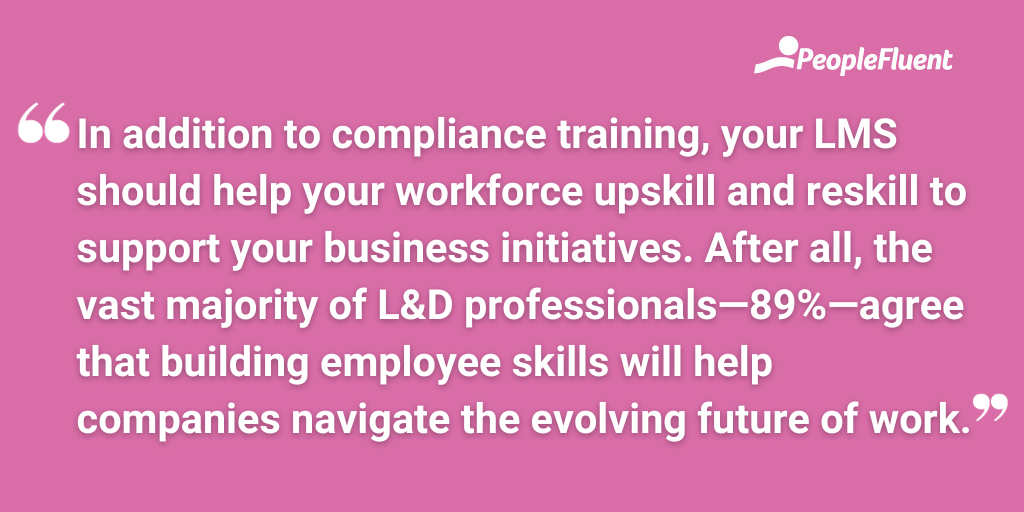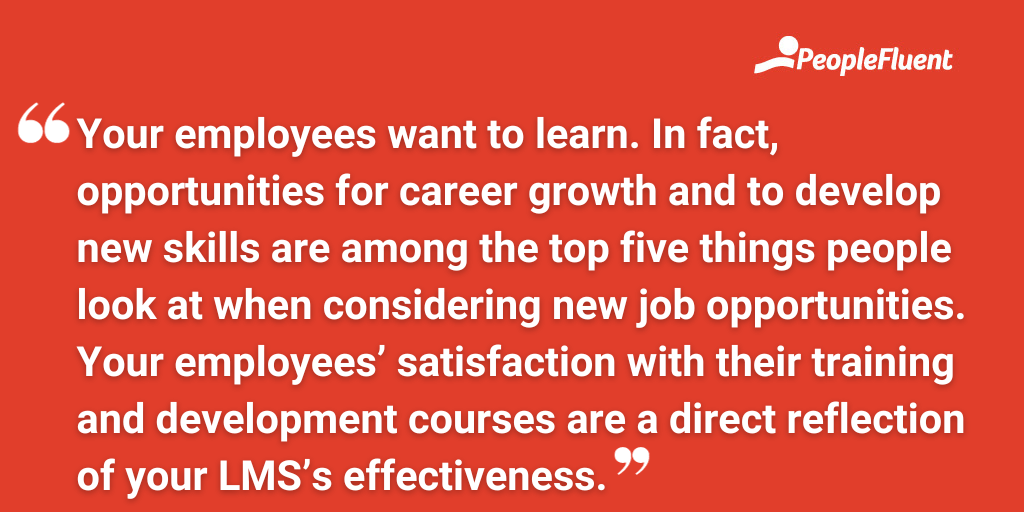Published: Oct 30, 2023Time to read: 8mins Category: Learning
3 Success-Driving Functions Every Compliance-Focused LMS Must Have
Although there are many learning management systems (LMSs) on the market, not every platform is designed to handle complex compliance training. Organizations in highly regulated industries need an LMS capable of ensuring compliance regulations are being met. This blog post details three functions every compliance-minded LMS should have. Plus, learn how to measure the success of your new LMS.
When you operate in industries like financial services, healthcare, manufacturing, and other high-consequence sectors, there isn’t room for clerical errors. Your employees must be up to date with the essential skills and knowledge needed to carry out their jobs, and you need to provide the training to prepare them—or else, you risk potentially catastrophic results.
A lack of training, or improper training, can lead to your organization dealing with:
- Fines from regulatory agencies
- Lawsuits
- Business disruptions
- Reputational damage
In severe circumstances, non-compliance and improper training can result in injuries or fatalities. Due to the nature of these organizations’ working conditions, it’s vital for businesses in highly regulated industries to consider an LMS with compliance-minded capabilities and features. Here are three things organizations in manufacturing, healthcare, logistics, and other highly regulated industries should look for in their learning software applications.

KEEP READING ABOUT WORKFORCE LEARNING | ‘How a Modern Learning Strategy Is Essential to Your Future Training Efforts’
1) Ability to Manage Industry-Specific Compliance Regulations
While every organization will have its own protocols and compliance training requirements for its workforce, some industries must adhere to strict standards and procedures in order to operate safely.
For example, industries regulated by the U.S. Food and Drug Administration (FDA) must adhere to Title 21 CFR Part 11. This regulation establishes the compliance requirements for electronic records and signatures. Organizations depend on the use of electronic signatures to prevent business slowdowns, but food and beverage manufacturers, pharmaceutical companies, clinical laboratories, and other organizations regulated by the FDA must adhere to strict rules regarding these digital signatures.
Similarly, regulated industries in the European Union like pharmaceutical, biotechnology, and medical device firms must adhere to Annex 11. This regulation is like Title 21 CFR in that it also establishes compliance requirements related to electronic records and signatures.
Learning management vendors that specialize in highly regulated industries understand the complexities of adhering to regulations like Title 21 CFR Part 11 and Annex 11. Compliance data must be recorded, validated, and audited by organizations to meet these regulatory requirements, and these processes can be extensive.
MORE ON INDUSTRY-SPECIFIC REGULATIONS | Frequently Asked Questions About 21 CFR Part 11
2) Robust System Auditing Capabilities
Complex industries require thorough system audits. In order to stay compliant with various regulations (including the aforementioned Title 21 CFR Part 11), you’ll need detailed audit logs. These sets of organizational records indicate:
- When specific actions are taken within your organization’s systems
- Who initiated the actions
- What time the events occurred
- How the actions relate to an overall chain of events
In order to prove compliance, you’ll need to be able to show that you have these records to clearly indicate which of your employees are up to date with their training courses and who has had access to your systems.
To meet such stringent requirements, it’s important that you implement an LMS with advanced auditing capabilities. While most learning platforms allow you to generate reports, not all reports will allow for the higher level of detail and customization required in sectors like manufacturing, financial services, and healthcare.
Therefore, you should choose an LMS capable of auditing which users have completed training, who has accessed the system, and who has made changes. Your LMS reports should also indicate more specific details, such as IP addresses for users with timestamps marking when various events take place.

CONQUER COMPLEX TRAINING NEEDS | ‘4 Ways PeopleFluent Learning Helps Organizations in Highly Regulated Industries’
3) Integration With Your Other Systems
While compliance management is essential for businesses to operate efficiently, it shouldn’t be the sole focus of your LMS. In addition to compliance training, your LMS should help your workforce upskill and reskill to support your business initiatives. After all, the vast majority of L&D professionals—89%—agree that building employee skills will help companies navigate the evolving future of work.
To help you best support your workforce’s development, your LMS should have integration capabilities with other systems. When your learning software integrates with talent management systems, your L&D teams can supplement learner information with important course completion data. This allows your teams to run deeper analytics and use the information to target essential learning needs and areas of improvement within your organization.
How to Measure the Success of Your New LMS
How your organization defines success will vary depending on your industry requirements and your specific business objectives. Evaluating the return on investment (ROI) of your LMS can be tricky, but there are a few ways you can determine whether you’ve made the right investment with your new learning software.
Calculate Your Time Savings
Your learning software likely won’t be the direct source of increased revenue for your business. Nonetheless, you can estimate your ROI in terms of how much time your employees save by leveraging the LMS.
A robust learning management system can be configured to automatically place employees in the appropriate learning paths according to their roles within your organization. The right LMS can also automate other time-consuming tasks for your L&D administrators, such as sending course completion reminders and generating reports.
When your LMS does the heavy lifting, your trainers and learning designers can focus on how to improve the professional development experience for your employees, rather than spend precious time sending emails and manually placing people into courses.

FUTURE-PROOF YOUR WORKFORCE | ‘How Compliance Training in Your LMS Protects Your High-Consequence Organization’
Demonstrate Proof of Workforce Upskilling
Nearly everyone will need to upskill at some stage in their career, and your LMS will play a key role in building these essential skills for the future. According to the World Economic Forum, six in ten workers will require skills training by 2027, yet only half of these workers have access to adequate training resources. With this in mind, you can measure the ROI of your learning solution by demonstrating whether it’s been an effective means of upskilling and reskilling your employees.
To start, you’ll need to conduct a skills gap analysis prior to implementing your LMS. You’ll likely do this anyway as part of determining your value proposition prior to choosing your vendor, so be sure to keep the data handy. Once your workforce has been training with your new LMS for six to nine months, conduct another workforce skills assessment. Compare the data from your pre- and post-implementation assessments to determine the skills growth within your organization and quantify the ROI on your LMS.
Look at Employee Satisfaction
Your employees want to learn. In fact, opportunities for career growth and to develop new skills are among the top five things people look at when considering new job opportunities. Your employees’ satisfaction with their training and development courses are a direct reflection of your LMS’s effectiveness.
To use employee satisfaction as a measure of LMS success, you’ll need a basis for comparison. Worker surveys conducted both pre- and post-implementation are a good starting point to get direct feedback from your employees. You should see an uptick in self-reported satisfaction with your new LMS, but be sure to conduct your post-implementation survey after your workforce has had enough time to adjust to the new system.
You can also compare employee engagement levels from your prior learning solution with your new LMS. Your new LMS should include robust reporting features that you can use to determine whether your workforce is more or less engaged with learning and training initiatives using your new software solution.
Keep Compliance Top of Mind
It will take some time before you’ll know for certain whether your new LMS implementation is successful. If all goes well, you should see an increase in your employees’ skill attainment and overall satisfaction, and possibly some time savings for your L&D team. Ultimately, the right LMS will manage your professional learning needs while driving your organizational success.
Employees in highly regulated industries need to be up to speed with essential skills and knowledge to do their jobs properly. An LMS designed to deliver complex compliance and skills training can help organizations ensure their workforce is prepared. Managing industry-specific training requirements for hundreds or thousands of employees, performing extensive learning audits, and integrating seamlessly with other systems are essential capabilities for any company operating in highly regulated sectors. Without these functionalities, delivering essential training will be cumbersome and time-consuming.
Discover How to Choose an LMS That Handles Your Complex Compliance Needs
Continue learning about choosing an LMS that’s right for your organization by downloading our ebook, ‘How Enterprise Companies in Highly Regulated Industries Choose the Right LMS.’ Or if you’re ready to try a solution that ticks every box, get a demo of the PeopleFluent LMS today.